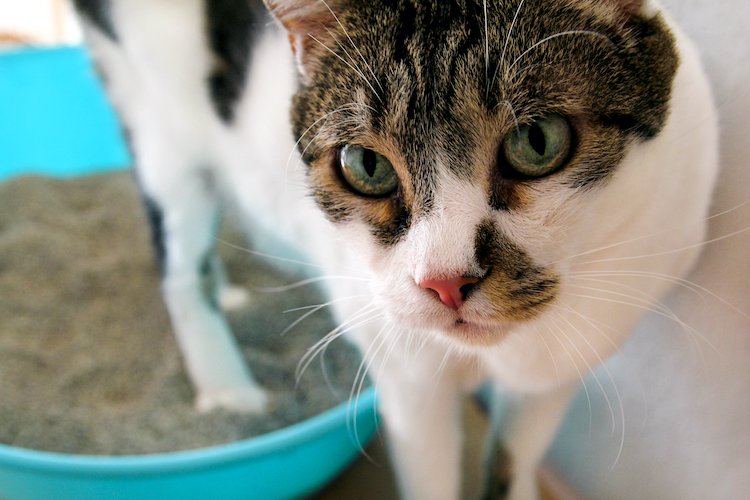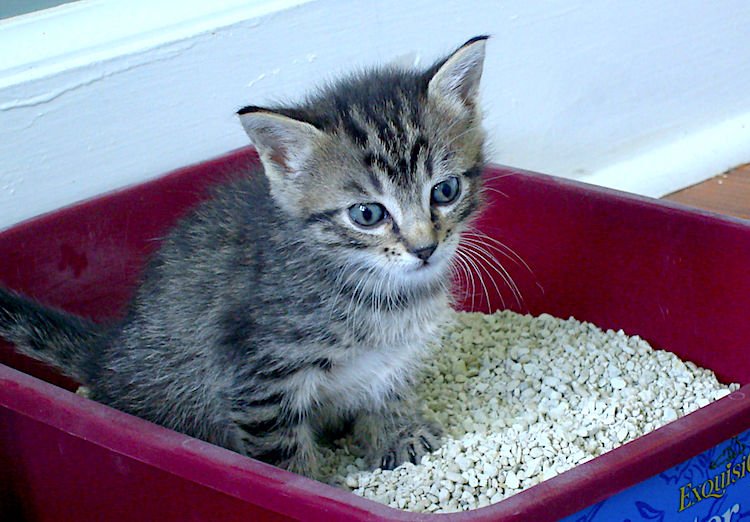This pet health content was written by a veterinarian, Dr. Pippa Elliott, BVMS, MRCVS. It was last reviewed on September 6, 2024
If you have questions or concerns, call your vet, who is best equipped to ensure the health and well-being of your pet. This article is for informational purposes only and is not a substitute for professional medical advice, diagnosis, or treatment. See additional information.

Can a Dirty Litter Box Cause Cat Urinary Tract Infection?
Can cats get bladder infections from a dirty litter box? Yes and no.
Yes, dirty litter boxes can cause bladder problems — but not so much infection as the inflammatory condition known as feline lower urinary tract disease (FLUTD) (Pandora Syndrome in Cats).
To put it simply, a dirty litter box is a bad idea for several reasons:
- It can cause your cat significant distress.
- It may lead to cat urinary tract infection or bladder inflammation.
- It often results in expensive veterinary visits (Veterinary Care Costs).
Maintaining a clean litter box is essential for both your cat’s health and your wallet.
The Link Between a Dirty Litter Box and Cat Urinary Tract Infection
Cats find a dirty litter box an affront to their dignity.
Without the cat equivalent of a clean toilet and soft toilet paper, they face a stark choice:
- Hold on and hope someone finally cleans the tray.
- Use a facility they find repellent.
- Find their own spot to relieve themselves.
These decisions create stress, which is more than just an emotional issue for cats. Stress causes an increase in hormones like cortisol and adrenaline, leading to physical effects, including bladder inflammation.
Here’s how it unfolds:
- Stress (Stress in Pets) leads to inflammation of the nerves that supply the bladder.
- This results in inflammation of the bladder wall, which makes the cat feel like they need to pee.
- But when the litter box is dirty (Litter Box Maintenance), they may avoid it, leading to more stress.
It’s a vicious circle (Cat Bladder Problems) of stress and bladder issues that often doesn’t end well.
Infection vs. Inflammation
But what about infection?
A true urinary tract infection (UTI) is relatively uncommon in cats, especially in younger ones. According to statistics:
- Out of 100 young cats showing signs of difficulty peeing, only 3 will have an infection.
- The other 97 cases are typically due to bladder inflammation.
However, bladder infections become more common (Most Common Cat Health Problems) in:
The challenge lies in the fact that the symptoms of a urinary tract infection are the same as those of bladder inflammation. So, what are the signs?
Symptoms of a Cat Urinary Tract Infection or Bladder Problem
Long story short, all cats with a sore bladder should see a veterinarian. While the signs may look similar, the causes and treatments can vary significantly.
A cat, especially a male, having difficulty peeing is at risk of a complete blockage, which can become life-threatening. The signs that signal a bladder problem include:
If ignored, these signs could lead to a blocked urethra, which is an emergency:
Untreated blockage can result in lasting kidney damage or even sudden death from a heart attack. Hence, it’s crucial to see a vet as early as possible.

Is a Dirty Litter Box the Only Cause of Cat Urinary Tract Infection and FLUTD?
A dirty litter tray is definitely a source of stress, but it’s not the only tray-related issue that can lead to feline lower urinary tract disease (FLUTD) or cat urinary tract infection.
Consider these additional factors:
- Feral cats (How to Help Feral Cats) naturally use separate spots to urinate and defecate. Cats prefer to keep their business separate, and for a sensitive house cat, using one tray for both functions can be highly stressful.
- In a multi-cat household (Multi-Cat Household Tips), each cat should have their own litter tray. The golden rule is one litter box per cat, plus one spare. For example, if you have 3 cats, that means 4 trays.
Other sources of stress can include:
- The location of the tray. For example, if it’s placed near a washing machine, a cat may associate the loud noises with trauma every time they try to use the litter box.
- The type of litter. Cats are creatures of habit, so stick to a familiar substrate that your cat knows and loves. Switching to a new type of litter can cause distress.
Following these guidelines can help reduce stress for your cat and lower the risk of bladder issues.
Treatment and Prevention of Cat Urinary Tract Infection and FLUTD
Prevention is always better than cure. Here are some suggestions to help keep your cat stress-free and lower the risk of developing cat urinary tract infection or FLUTD:
- Provide plenty of trays (one per cat, plus one spare).
- Place each tray in its own private spot (don’t line them up in a row).
- Stick with one brand of cat litter.
- Don’t place food or water bowls beside the tray.
- Keep the box clean.
- Maintain a relaxed atmosphere in your home.
If your cat develops symptoms, always consult a vet. The vet will typically check if the bladder is blocked. For non-blocked cats, treatment often includes non-steroidal anti-inflammatories, such as meloxicam, to reduce bladder soreness.
In more severe cases, such as a blocked bladder, the cat may need heavy sedation or anesthesia to relieve the blockage using a catheter. The vet may also want to investigate possible physical causes of bladder pain, such as:
For recurrent cases, the vet may recommend calming strategies, such as Zylkene (Zylkene Supplement) or Feliway (Feliway Diffuser), as well as improved litter box hygiene.

3 Common Causes of Cat Urinary Tract Infection or Bladder Infections
So, what if your young cat is one of the 3% that develops a bladder infection? Here are the main causes:
Stress, which can lead to bladder inflammation.
An Ascending Infection
This occurs when bacteria travel from the outside inward, often linked to a dirty litter box. When a cat’s rear end becomes soiled with feces, bacteria can move into the urethra and travel upward to the bladder. Female cats are more prone to this type of infection due to their anatomy. Ascending infections are also more likely in:
- Cats with poor personal hygiene.
- Cats with long fur, which can trap more bacteria.
- Cats who like to sleep in the litter box (Why Cats Sleep in Litter Boxes).
Poor-Quality Urine
Normally, urine has disinfectant properties. However, certain health problems can alter a cat’s biochemistry and reduce the quality of their urine. For example:
- Kidney disease (Kidney Failure in Cats) can prevent the kidneys from concentrating urine, making it too watery and less effective at killing bacteria.
- Diabetic cats (Caring for Diabetic Cats) often have glucose in their urine, which “feeds” bacteria, increasing the likelihood of a urinary tract infection.
Poor Bladder Health
Even if bacteria are present in the urine, a healthy bladder can often prevent infection. However, when bladder health is compromised, bacteria can gain a foothold. Examples of damage to the bladder include:
- Crystals in the urine acting like abrasive sandpaper.
- Bladder stones, which rattle around like a shoe in a dryer.
- Bladder polyps or cancer.
- Stress, which can lead to bladder inflammation.

How Are Cat Urinary Tract Infections Diagnosed?
When the symptoms of an infection are the same as those of inflammation, how does a vet make a diagnosis?
In most cases, the vet will submit a urine sample (What You Can Learn From a Urine Test) for culture. This process attempts to:
- Grow any bacteria present in the sample.
- Identify which antibiotic will effectively eliminate the infection.
Alternatively, vets can perform a simple in-house lab test that gives a “yes/no” result on whether an infection is present. If the test is positive, a sample may still be sent for culture, but this avoids unnecessary testing.
In some cases, especially with new patients, a vet may decide to treat the infection with antibiotics without waiting for a culture. However, if symptoms return after the treatment finishes, a culture will be necessary to identify the root cause and determine the most effective treatment.
How Do You Collect a Urine Sample From a Cat?
Collecting a urine sample from a cat can be tricky, but it’s essential for diagnosing cat urinary tract infections. Here are a few methods to help:
- Take a clean, empty litter box and use nonabsorbent pellets, such as Katkor (Katkor Urine Collection). These small plastic beads don’t soak up the urine. Once your cat uses the tray, you can use a pipette to collect the sample.
- Another option is to use aquarium gravel. Rinse it well to remove dirt and dust, disinfect it with boiling water, and let it dry completely before placing it in the tray.
If you’re unable to collect a sample at home, speak to your vet. They may use:
- Cystocentesis, a procedure where a sterile needle is inserted into the full bladder to collect a urine sample (Cystocentesis Procedure).
- Alternatively, the vet may hospitalize your cat until they can collect a urine sample.
Final Thoughts on Cat Urinary Tract Infection
So, to recap: Can cats get urinary tract infections from a dirty litter box?
The answer is yes … and no. While a dirty litter box can lead to bladder inflammation and stress, which increases the risk of cat urinary tract infection, infections themselves are relatively rare in younger cats. However, maintaining a clean litter box is essential for preventing stress-related bladder issues like FLUTD.
The take-home message? A clean litter box makes for a healthy, happy cat — and that’s what we all want at the end of the day.
In the video below, Dr. Patrick McHale, DVM, shares more about how veterinarians treat urinary tract infection in cats:
Frequently Asked Questions (FAQ)
What antibiotic is used for cat urinary tract infection?
The most commonly used antibiotics for cat urinary tract infections are amoxicillin or clavamox, but it depends on the specific infection and bacterial strain.
How to treat cat urinary tract infection?
Treatment for a cat urinary tract infection typically involves antibiotics prescribed by a veterinarian, along with increased water intake and improved litter box hygiene.
How do you know if your cat has a urinary tract infection?
Signs of a urinary tract infection in cats include frequent trips to the litter box, straining to urinate, blood in the urine, and vocalization during urination.
References
- Brown, Scott A., VMD, PhD, DACVIM. “Obstructive Uropathy in Small Animals.” Merck Veterinary Manual. https://www.msdvetmanual.com/urinary-system/noninfectious-diseases-of-the-urinary-system-in-small-animals/obstructive-uropathy-in-small-animals.
- Downing, Robin, DVM, DAAPM, DACVSMR, CVPP, CRPP. “Urinary Tract Infections (UTIs) in Cats.” VCA Hospitals. 2016. https://vcahospitals.com/know-your-pet/urinary-tract-infections-utis-in-cats.
- “Feline Lower Urinary Tract Disease (FLUTD).” International Cat Care. Aug. 20, 2018. https://icatcare.org/advice/feline-lower-urinary-tract-disease-flutd/.
- “Feline Idiopathic Cystitis (FIC).” International Cat Care. Aug. 20, 2018. https://icatcare.org/advice/feline-idiopathic-cystitis-fic/.


